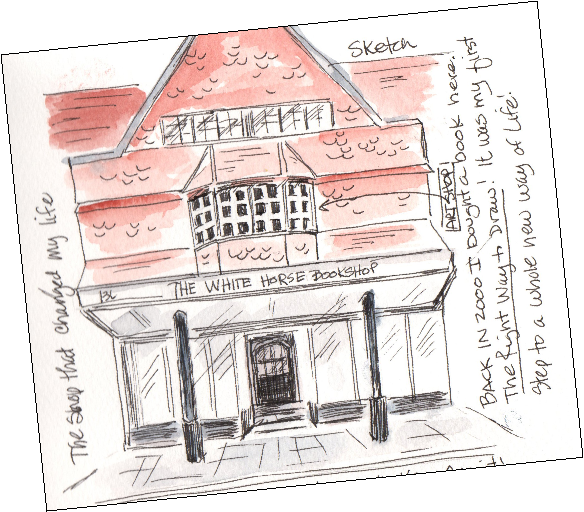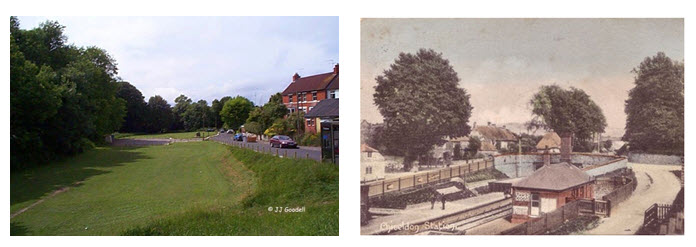A visit to a small
art shop
One
day while visiting in a nearby market town, I ran across a small art shop. I'm
talking really, really small. On one of the few shelves, gracing their walls
was a book, entitled, The Right Way to Draw by Mark Linley. I hadn't done any real
drawing for years. In fact, most of my advertising work was designing and writing
copy. The computer age had tossed me into creating in front of a screen, either
designing/writing ads or creating websites. My pencils, pens and brushes were
gathering dust along with my other graphic tools.
Big things can happen from small acts
Does
anyone ever know when one small act can change an entire life? That's what
happened when I purchased this book. I spent less than ten dollars that day,
without knowing how rich I would become (not necessarily monetarily) in the
years ahead.
I took the book home. Alex and I poured over it and we began to following the author's instructions. Inspiration abound. I bought some real art pencils and a sketchbook. Alex was so interested in getting back to doing something with his hands, he opted to start putting model cars and airplanes together. We even bought a small table and tried to make the garage into our "art studio." Unfortunately, it was too dark, so we did a lot of our work outside, when it wasn't raining.
Your life can change when you least expect it
 |
| This is where it all started! |
Of course my drawings were primitive in the beginning. But most importantly, I liked doing it! I would set upon a subject and the time would fly by. Every worry or concern melted away while I added line here and shadow there. I eventually bought Linley's other books The Right Way to Draw Landscapes and The Right Way to Draw Flowers. I still own them today and all three are yellowing with age.
All three of these books are simple both the text as well as the examples. There's nothing elaborate at all inside. But the key was his first chapter in the original book, entitled, You Can Learn to Draw. He goes on to explain that we should all expect mistakes, be willing to learn a new skill, have the courage to think positive, be patient and use the right materials.
Drawing is a skill
From
this small book purchased in an ever so small art stop in England, I began to
draw. I did so every day (I still do) for the last 14 years. It was hard in the
beginning and yes! I made lots of mistakes. What I learned though is that
drawing is a skill that can be learned just like tennis or piano. It's take commitment.
The difference between someone who can draw and someone who can’t isn’t talent
at all. It’s being willing to work at it through trial and error, through
practice. There’s no magic pill. You put the time in, you get results!
As most of you know, the rest is history. I returned home and took out every book I could find in the library on drawing. I signed up for drawing and painting classes. I started to create a small library of my own art books--really treasurers sheathe between two covers. And while I've been in art commercially since I was 18 years old, I eventually left that behind to begin a whole new world in fine arts--and I've never looked back. I've been given the rare opportunity to share my knowledge and skill to others through my classes and workshops. And I have Mark Linley and that small art shop to thank. Without them, the whole story would have been different.
What's coming up?
Summer Art Fun
PCC
Sylvania Campus
Saturday One-Day Workshops
Saturday One-Day Workshops
Drawing with Colored Pencil
Saturday, July 12 · 10 am to 4 pm
Drawing with Pen and Ink
Saturday, July 26 · 10 am to 4 pm
Call to register:
971-722-6266
Glastonbury Studios
Sketch’n on the Go™
Wednesday Outings
July 9--Mountainside Lavender Farm, Scholls
July 23--Red Ridge Farm, Dayton (nr. Dundee)
10:00 am to 12:30 pm
Fee $25 per outing
To register and for more details email: jjgoodell@gmail.com
+++++++++++++++++++
Second Sunday Visual Journaling
Sunday, July 13 · 1 pm to 4 pm
http://journalingpaperandpen.blogspot.com/
(no class in August)
Wednesday Outings
July 9--Mountainside Lavender Farm, Scholls
July 23--Red Ridge Farm, Dayton (nr. Dundee)
10:00 am to 12:30 pm
Fee $25 per outing
To register and for more details email: jjgoodell@gmail.com
+++++++++++++++++++
Second Sunday Visual Journaling
Sunday, July 13 · 1 pm to 4 pm
http://journalingpaperandpen.blogspot.com/
(no class in August)
++++++++++++++++
Now taking registration applications
for Fall classes 2014
for Fall classes 2014
Tuesday evenings 7-9 Drawing
Wednesday mornings 10 to 12:30 Sketching
Thursday evenings 6:30 to 9 Intermediate Acrylic Painting
To register email: jjgoodell@gmail.com
First come, first served. Payment guarantees placement.
To register email: jjgoodell@gmail.com
First come, first served. Payment guarantees placement.
++++++++++++++++++++++
2015 Sketch’n on the
Go™ Workshop
Mediterranean Sketching Workshop, Part II
7-Night France, Italy & Malta Cruise
April 26 to May 3, 2015
See website for details: http://sketchingthemediterranean.blogspot.com/
Check this out:
Cruise line is now offering buy one passage, get second half off until July 15th
+++++++++++++++++++++
Added by popular demand
In-studio Beginning Watercolor Workshop
Saturday, October 18
10 am to 4 pm
Tigard Studio
All supplies provided, including lunch
$95
Pre-registration required. Payment reserves your seat.
To register email: jjgoodell@gmail.com
Mediterranean Sketching Workshop, Part II
7-Night France, Italy & Malta Cruise
April 26 to May 3, 2015
See website for details: http://sketchingthemediterranean.blogspot.com/
Check this out:
Cruise line is now offering buy one passage, get second half off until July 15th
+++++++++++++++++++++
Added by popular demand
In-studio Beginning Watercolor Workshop
Saturday, October 18
10 am to 4 pm
Tigard Studio
All supplies provided, including lunch
$95
Pre-registration required. Payment reserves your seat.
To register email: jjgoodell@gmail.com










